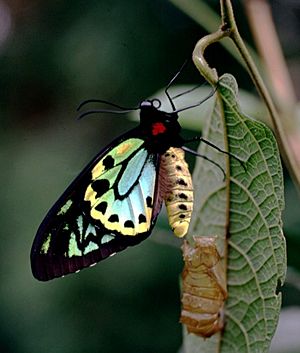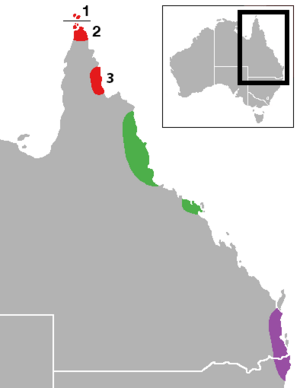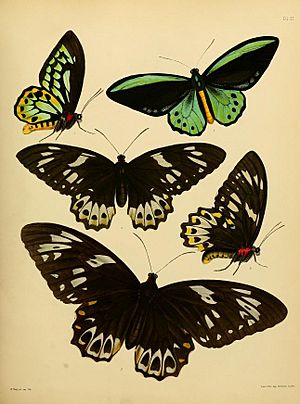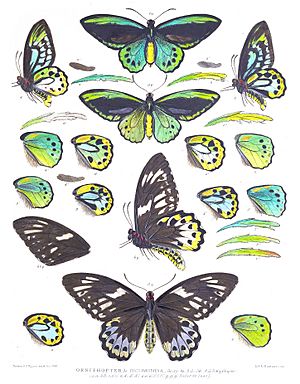Richmond birdwing facts for kids
Quick facts for kids Richmond birdwing |
|
|---|---|
 |
|
| Live male specimen | |
| Conservation status | |
| Scientific classification | |
 |
|
| Distribution of Ornithoptera richmondia (in purple) and other species of Ornithoptera in Australia | |
| Synonyms | |
|
The Richmond birdwing (scientific name: Ornithoptera richmondia) is a special type of birdwing butterfly. It lives only in Australia, meaning it is endemic there. It is the second smallest of all the birdwing butterflies. The smallest one is called Ornithoptera meridionalis.
Contents
Where Do Richmond Birdwings Live?
Long ago, Richmond birdwings lived in rainforests from Maryborough in Queensland down to the Clarence River in New South Wales. But over time, many of these rainforests were cut down. This means the butterflies now live in much smaller areas.
Today, you can find them in places like Kin Kin, Pomona, and the Blackall Range in Queensland. South of Brisbane, they live near the Nerang River and Tallebudgera valleys. They are especially safe in the national parks close to the Queensland-New South Wales border.
In New South Wales, they are found in rainforests as far south as the Blackwall Range near Wardell. Sometimes, these butterflies live high up in the mountains. However, it gets too cold in winter, so these groups often die out. New butterflies have to fly up from warmer lowland areas to keep these mountain populations going.
If you want to see a Richmond birdwing, a good place to visit is the car park at the bottom of Mount Warning in Mount Warning National Park, New South Wales. If the weather is good during their flight season, you will almost certainly spot one!
How Many Are There? (Conservation Status)
The Richmond birdwing has not been officially listed by a big international group called IUCN. However, some experts believe it should be listed as "vulnerable." This means it could be at risk because it has lost so much of its natural home.
In New South Wales, it is not currently a big concern. In Queensland, it is considered "least concern," meaning it's at low risk. But this butterfly used to be much more common, especially in Queensland. In the early 1900s, it was often seen in Brisbane.
North of Brisbane, these butterflies now only live in small parts of rainforest that are left. Only a few groups are safe in national parks or forest reserves. The Connondale and Blackall ranges are important strongholds. South of the Nerang River, like in Lamington National Park, there are more Richmond birdwings.
One of the biggest problems for these butterflies is habitat loss. This happens when their rainforest homes are destroyed for houses, shops, or other human activities. Another big threat is a non-native plant called Aristolochia littoralis, also known as Dutchman's pipevine.
Helping the Richmond Birdwing
A retired scientist named D.P.A. Sands has been leading projects to help the Richmond birdwing. One project involved planting a special vine called Aristolochia praevenosa in schools and nature reserves. This vine is the butterfly's main food plant.
Now, the Richmond Birdwing Butterfly Recovery Network works to connect different groups of butterflies. They do this by planting more food plants and taking care of the ones already planted. They also teach people about the butterfly and why it's important to protect rainforests. These efforts have been very successful in making the Richmond birdwing a symbol for rainforest protection in southeastern Queensland.
Life Cycle and What They Eat
Richmond birdwings usually eat only two types of native plants from the Aristolochiaceae family. These are the Richmond birdwing butterfly vine (Aristolochia praevenosa) in lowland areas and Aristolochia laheyana in mountain areas.
They can also lay eggs on a non-native plant called Aristolochia tagala. However, the caterpillars don't grow well on this plant if they started on their usual food.
A Big Danger: Dutchman's Pipevine The butterflies sometimes lay eggs on an introduced plant called calico flower (Aristolochia littoralis), also known as Dutchman's pipevine. But if the caterpillars eat this plant, it kills them! Because of this, people are strongly asked not to grow or sell A. littoralis where Richmond birdwings live. This plant is also harmful to other Australian butterflies, including other birdwings.
The two native Aristolochia plants that Richmond birdwings eat are thought to have special chemicals. These chemicals are poisonous to animals that might try to eat the caterpillars.
How Caterpillars Grow
Richmond birdwing caterpillars need very specific conditions to survive. This is why they don't usually live permanently in home gardens. The female butterfly lays her eggs on the soft new leaves of vines that reach high into the tree canopy. The eggs hatch in about a week.
When a caterpillar first hatches, it eats its own eggshell. Then, it needs very soft leaves to eat, as it cannot chew older, tougher leaves. These caterpillars eat a lot! A single caterpillar might need a 10-year-old vine to get enough food.
When the caterpillar is fully grown, it usually moves away from its food plant to turn into a pupa. This is because caterpillars can sometimes eat each other. The pupae hang upside down, held by a silk pad and a silk belt around their middle. They need a safe place to spend the winter. The Richmond birdwing is the only birdwing butterfly known to go into a true diapause. This is like a deep sleep to survive cold weather.
Small wasps, tiny mites, and some rainforest birds can eat the young caterpillars and pupae.
Adult Butterflies: Flying and Finding Mates
Adult Richmond birdwings are very strong fliers. They are usually most active in the early morning and near dusk. During these times, you can often see them feeding on flowers like Lantana, eucalypts, and Melaleuca trees. If you look for them at other times of the day, you might think they are rare, even if there are many in a small area.
Female butterflies are sometimes seen far away from their usual homes. After years with lots of rain, they might even migrate (travel) to the Queensland-New South Wales border ranges. These migrations allow new groups to form in the mountains during summer, but they usually die out in winter because of the cold.
Birdwing butterflies fly in a very graceful way. They use their front wings to create most of the power, moving them in a wide circle. Their back wings act almost like a tail to help them steer. If something disturbs them, their flight becomes very fast and jerky, weaving in and out of leaves. They usually fly high up in the rainforest canopy. They only come down to feed on flowers or lay eggs on their food plants.
Male butterflies often claim areas along creeks or in rainforest clearings. They fly around these areas during the day, especially at dawn and dusk. When a male wants to find a mate, he will chase the female. Then, he hovers above her, releasing special scents called pheromones. If the female is not ready to mate, she will stay still and prevent the male from landing and pairing with her.





